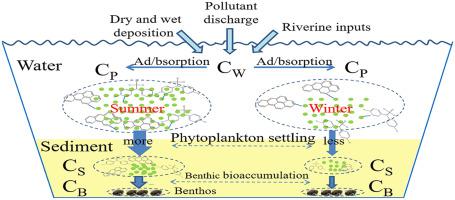Ecotoxicology and Environmental Safety ( IF 6.2 ) Pub Date : 2021-02-11 , DOI: 10.1016/j.ecoenv.2021.112017 Qiqi Ding , Xionghu Gong , Miao Jin , Xiaolong Yao , Lu Zhang , Zhonghua Zhao

|
The distribution of hydrophobic organic contaminants (HOCs) in eutrophic ecosystems has been widely studied, but how phytoplankton blooms affect their occurrence and benthic bioaccumulation is poorly understood. To fill this knowledge gap, the biological pump effects of phytoplankton on the fate of organochlorine pesticides (OCPs) and polycyclic aromatic hydrocarbons (PAHs) in sediments and benthos (Corbicula fluminea) from Lake Taihu, a hypereutrophic lake in China, were identified. The spatial-temporal distribution of HOCs suggests that higher phytoplankton biomass, coupled with sediment organic matter (SOM) content, greatly increased the concentration of HOCs in sediments in both winter and summer seasons. This could be attributed to the biological pump effects sequestering more HOCs from water to sediments with settling phytoplankton, especially during the summer. The biological pump effects further promoted the uptake of sediment-bound HOCs by benthos. The significant positive relationships between concentrations of HOCs in sediments and benthos were observed during the winter dormancy phase of benthos. Furthermore, the benthic bioaccumulation of HOCs could be strengthened by phytoplankton, due to their contribution to SOM and the following increased bioavailability of HOCs in sediments. Further research is needed to elucidate the phytoplankton biological pump effects on the fate of HOCs in benthic food chain, especially for hypereutrophic waters.











































 京公网安备 11010802027423号
京公网安备 11010802027423号